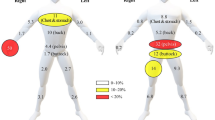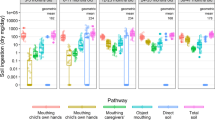Abstract
In vitro assessments of 14C-benzo[a]pyrene (BaP) absorption through human epidermis were conducted with the sub-63-μm fraction of four test soils containing different amounts of organic and black carbon. Soils were artificially weathered for eight weeks and applied to epidermis at nominal BaP concentrations of 3 and 10 mg/kg for 8 or 24 h. Experiments were also conducted at 24 h with unweathered soils and with BaP deposited onto skin from acetone at a comparable chemical load. For the weathered soils, absorption was independent of the amount of organic or black carbon, the mass in the receptor fluid was proportional to exposure duration but independent of concentration, and the mass recovered in the skin after washing was proportional to concentration and independent of exposure time. Results from the weathered and unweathered soils were similar except for the mass recovered in the washed skin, which was lower for the weathered soil only at the higher concentration. We hypothesize that chemical concentrations exceeded the BaP sorption capacity accessible within the artificial weathering timeframe for all soils tested, and that BaP mass in the washed skin was dominated by particles that were not removed by washing. Fluxes into and through skin from soils were lower by an order of magnitude than from acetone-deposited BaP.
This is a preview of subscription content, access via your institution
Access options
Subscribe to this journal
Receive 6 print issues and online access
$259.00 per year
only $43.17 per issue
Buy this article
- Purchase on Springer Link
- Instant access to full article PDF
Prices may be subject to local taxes which are calculated during checkout



Similar content being viewed by others
References
ATSDR. Priority List of Hazardous Substances. 2014; Available at: http://www.atsdr.cdc.gov/spl/ (accessed on 22 August 2014).
Yang JJ, Roy TA, Krueger AJ, Neil W, Mackerer CR Percutaneous absorption of benzo(a)pyrene from soils with and without petroleum crude contamination. In: Calabrese EJ, Kostecki PT (eds). Petroleum Contaminated Soils. Lewis Publishers: Chelsea, MI. 1989 p. 399–407.
Wester RC, Maibach HI, Bucks DA, Sedik L, Melendres J, Liao C et al. Percutaneous absorption of [14C]DDT and [14C]benzo[a]pyrene from soil. Fundam Appl Toxicol 1990; 15: 510–516.
Roy TA, Yang JJ, Krueger AJ, Mackerer CR . In vitro percutaneous absorption of benzo(a)pyrene from crude oil sorbed on soil using rat and human skin [abstract only]. Toxicology 1992; 12: 114.
Yang JJ, Roy TA, Krueger AJ, Neil W, Mackerer CR . In vitro and in vivo percutaneous absorption of benzo[a]pyrene from petroleum crude-fortified soil in the rat. Bull Environ Contam Toxicol 1989; 43: 207–214.
Abdel-Rahman MS, Skowronski GA, Turkall RM . Assessment of the dermal bioavailability of soil-aged benzo(a)pyrene. Hum Ecol Risk Assess 2002; 8: 429–441.
Moody RP, Chu I . Dermal exposure to environmental contaminants in the Great Lakes. Environ Health Perspect 1995; 103: 103–114.
Roy TA, Krueger AJ, Mackerer CR, Neil W, Arroyo AM, Yang JJ . SAR models for estimating the percutaneous absorption of polynuclear aromatic hydrocarbons. SAR QSAR Environ Res 1998; 9: 171–185.
Roy TA, Singh R . Effect of soil loading and soil sequestration on dermal bioavailability of polynuclear aromatic hydrocarbons. Bull Environ Contam Toxicol 2001; 67: 324–331.
Stroo HF, Roy TA, Liban CB, Kreitinger JP . Dermal bioavailability of benzo[a]pyrene on lampblack: implications for risk assessment. Environ Toxicol Chem 2005; 24: 1568–1572.
Moody RP, Joncas J, Richardson M, Chu I . Contaminated soils (I): in vitro dermal absorption of benzo[a]pyrene in human skin. J Toxicol Environ Health A 2007; 70: 1858–1865.
Duff RM, Kissel JC . Effect of soil loading on dermal absorption efficiency from contaminated soils. J Toxicol Environ Health 1996; 48: 93–106.
Touraille GD, McCarley KD, Bunge AL, Marty JP, Guy RH . Percutaneous absorption of 4-cyanophenol from freshly contaminated soil in vitro: effects of soil loading and contamination concentration. Environ Sci Technol 2005; 39: 3723–3731.
Spalt EW, Kissel JC, Shirai JH, Bunge AL . Dermal absorption of environmental contaminants from soil and sediment: a critical review. J Expos Sci Environ Epidemiol 2009; 19: 119–148.
Ruby MV, Lowney YW, Bunge AL, Roberts SM, Gomez-Eyles JL, Ghosh U et al. Oral bioavailability, bioaccessibility, and dermal absorption of PAHs from soil—state of the science. Environ Sci Technol 2016; 50: 2151–2164.
Grossman A, Ghosh U . Measurement of activated carbon and other black carbons in sediments. Chemosphere 2009; 75: 469–475.
Choate LM, Ranville JF, Bunge AL, Macalady DL . Dermally adhered soil: 1. Amount and particle-size distribution. Integr Environ Assess Manag 2006; 2: 375–384.
Reifenrath WG, Kammen HO, Palmer WG, Major MM, Leach GJ . Percutaneous absorption of explosives and related compounds: an empirical model of bioavailability of organic nitro compounds from soil. Toxicol Appl Pharmacol 2002; 182: 160–168.
Freeman GB, Johnson JD, Killinger JM, Liao SC, Davis AO, Ruby MV et al. Bioavailability of arsenic in soil impacted by smelter activities following oral administration in rabbits. Fundam Appl Toxicol 1993; 21: 83–88.
Freeman GB, Schoof RA, Ruby MV, Davis AO, Dill JA, Liao SC et al. Bioavailability of arsenic in soil and house dust impacted by smelter activities following oral administration in cynomolgus monkeys. Fundam Appl Toxicol 1995; 28: 215–222.
Roberts SM, Munson JW, Lowney YW, Ruby MV . Relative oral bioavailability of arsenic from contaminated soils measured in the cynomolgus monkey. Toxicol Sci 2007; 95: 281–288.
Bradley LJN, Magee BH, Allen SL . Background levels of polycyclic aromatic hydrocarbons (PAH) and selected metals in new England urban soils. J Soil Contam 1994; 3: 349–361.
Kay RT, Arnold TL, Cannon WF, Graham D, Morton E, Bienert R . Concentrations of Polycyclic Aromatic Hydrocarbons and Inorganic Constituents in Ambient Surface Soils, Chicago, Illinois: 2001–2002. US Geological Survey: Urbana, IL, 2003.
EPRI Polycyclic Aromatic Hydrocarbons in Surface Soils in Eastern Pennsylvania. Electric Power Research Institute: Palo Alto, CA. 2008 Contract No.: Product ID:1018272.
EPRI Polycyclic Aromatic Hydrocarbons (PAHs) in Surface Soils in Western New York: Follow-up Report for New York State Soils. Electric Power Research Institute: Palo Alto, CA. 2003 Contract No.: Product ID:1005296.
EPRI Polycyclic Aromatic Hydrocarbons (PAHS) In Surface Soil in Illinois. Electric Power Research Institute: Palo Alto, CA. 2004 Contract No.: Product ID:1011376.
EPRI Examination of the Sources of Polycyclic Aromatic Hydrocarbon (PAH) in Urban Background Soil 2008. Contract No.: Product ID:1015558.
Cross SE, Magnusson BM, Winckle G, Anissimov Y, Roberts MS . Determination of the effect of lipophilicity on the in vitro permeability and tissue reservoir characteristics of topically applied solutes in human skin layers. J Invest Dermatol 2003; 120: 759–764.
Frasch HF, Zang L-Y, Barbero AM, Anderson SE . In vitro dermal penetration of 4-chloro-3-methylphenol from commercial metal working fluid and aqueous vehicles. J Toxicol Environ Health A 2010; 73: 1394–1405.
Kissel JC . The mismeasure of dermal absorption. J Expo Sci Environ Epidemiol 2011; 21: 302–309.
Deglin SE, Dermal absorption of low volatility chemicals from soils. PhD thesis, Colorado School of Mines, Golden, CO, 2007.
Miller MM, Wasik SP, Huang GL, Shiu WY, Mackay D . Relationships between octanol-water partition coefficient and aqueous solubility. Environ Sci Technol 1985; 19: 522–529.
Mackay D . Multimedia Environmental Models: The Fugacity Approach 2nd edn CRC Press: Boca Raton, Florida, 2001.
Estimation Programs Interface Suite™ for Microsoft® Windows, v 4.11 - KOCWIN v 2.00 [database on the Internet]. United States Environmental Protection Agency. 2012a. Available at https://www.epa.gov/tsca-screening-tools/epi-suitetm-estimation-program-interface (accessed on 3 January 2015).
Hassett JJ, Means JC, Banwart WL, Wood SG . Sorption Properties of Sediments and Energy-Related Pollutants. United States Environmental Protection Agency, Environmental Research Laboratory: Athens, GA, EPA-600/3-80-014, April 1980 1980.
Means JC, Wood SG, Hassett JJ, Banwart WL . Sorption of polynuclear aromatic-hydrocarbons by sediments and soils. Environ Sci Technol 1980; 14: 1524–1528.
Deglin SE, Macalady DL, Bunge AL . Measuring the saturation limit of low-volatility organic compounds in soils: implications for estimates of dermal absorption. Sci Total Environ 2010; 408: 6100–6107.
White JC, Kelsey JW, Hatzinger PB, Alexander M . Factors affecting sequestration and bioavailability of phenanthrene in soils. Environ Toxicol Chem 1997; 16: 2040–2045.
White JC, Quiñones-Rivera A, Alexander M . Effect of wetting and drying on the bioavailability of organic compounds sequestered in soil. Environ Toxicol Chem 1998; 17: 2378–2382.
Alexander RR, Chung N, Alexander M . Solid-phase genotoxicity assay for organic compounds in soil. Environ Toxicol Chem 1999; 18: 420–425.
Kottler BD, White JC, Kelsey JW . Influence of soil moisture on the sequestration of organic compounds in soil. Chemosphere 2001; 42: 893–898.
Shelton DR, Sadeghi AM, Karns JS, Hapeman CJ . Effect of wetting and drying of soil on sorption and biodegradation of atrazine. Weed Sci 1995; 43: 298–305.
García-Valcárcel AI, Tadeo JL . Influence of soil moisture on sorption and degradation of hexazinone and simazine in soil. J Agric Food Chem 1999; 47: 3895–3900.
USEPA Risk Assessment Guidance for Superfund (RAGS), Volume I: Human Health Evaluation Manual (Part E, Supplemental Guidance for Dermal Risk Assessment) Final. Office of Superfund Remediation and Technology Innovation, USEPA, Washington, DC, July 2004.
USEPA IRIS assessment for benzo[a]pyrene. Environmental Protection Agency Science Advisory Board, Available at: http://yosemite.epa.gov/sab/sabproduct.nsf/0/4DCFD0E5F45A8CAD85257B65005B17C8?OpenDocument (accessed on 05 January 2015).
Acknowledgements
This work was funded by the Strategic Environmental Research and Development Program (SERDP) Project ER-1743 via subcontracts to the University of Washington and Colorado School of Mines from Exponent. The work has not been reviewed by the US Department of Defense, Department of Energy, or Environmental Protection Agency, and no endorsement should be inferred. We thank U. Ghosh, University of Maryland Baltimore County, for analysis of the carbon content of test soils; S. Roberts and J. Munson, University of Florida, for providing the radiolabeled BaP; and C. Heinen, A. Fretheim, K. M. Robertson and J. Levasseur for assistance with the experimental runs and sample processing.
Author information
Authors and Affiliations
Corresponding author
Ethics declarations
Competing interests
Funding for this research was provided by the Strategic Environmental Research and Development Program (SERDP). Y.W.L. works and M.V.R. worked for scientific consulting firms specializing in risk assessment services to private and public sector clients. With SERDP’s knowledge, they coordinate an industry-agency advisory group that receives updates on the project work, but does not control the direction of the research effort. The other authors declare no conflict of interest.
Additional information
Supplementary Information accompanies the paper on the Journal of Exposure Science and Environmental Epidemiology website
Supplementary information
Rights and permissions
About this article
Cite this article
Peckham, T., Shirai, J., Bunge, A. et al. Dermal absorption of benzo[a]pyrene into human skin from soil: Effect of artificial weathering, concentration, and exposure duration. J Expo Sci Environ Epidemiol 27, 610–617 (2017). https://doi.org/10.1038/jes.2016.61
Received:
Revised:
Accepted:
Published:
Issue Date:
DOI: https://doi.org/10.1038/jes.2016.61
Keywords
This article is cited by
-
RETRACTED ARTICLE: An in vitro model for quantifying chemical transfer from fabric to and through skin
Journal of Exposure Science & Environmental Epidemiology (2019)



